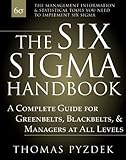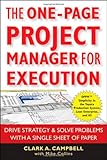The Six Sigma Handbook
Six Sigma is a system for improving the quality of organizational processes and products to a level of 3 defects per million–the “six sigma” level of quality. It was originally developed at Motorola in the 1980’s and has become one of the most widely discussed and reported trends in business over the past two years, thanks largely to the phenomenal successes of the Six Sigma program at GE, where CEO Jack Welch credits it with millions of dollars in annual cost savings and product quality improvements. Due to the widespread coverage of the Six Sigma program by the business press over the last two years, there is strong demand for books and information on how Six Sigma works and how to implement it. The Six Sigma Handbook is designed for the manager or quality professional who is already familiar with Six Sigma and wants a guide to the basic quality tools and statistics that are the foundation for Six Sigma. In addition to providing a brief overview of the management and organization of
List Price: $ 89.95
Price: $ 55.00
The One-Page Project Manager for Execution: Drive Strategy and Solve Problems with a Single Sheet of Paper
- ISBN13: 9780470499337
- Condition: New
- Notes: BRAND NEW FROM PUBLISHER! BUY WITH CONFIDENCE, Over one million books sold! 98% Positive feedback. Compare our books, prices and service to the competition. 100% Satisfaction Guaranteed
Drive Strategy With Simplicity–On A Single Sheet Of Paper!The One-Page Project Manager set a new standard as an understandable and easy-to-apply organizational tool, allowing managers to summarize complex projects on a single information-rich page. This book, third in the OPPM series, describes how to combine the OPPM with the Toyota A3 report to create an enhanced, integrated management tool. With a refreshingly clear style, the authors walk users through implementing the OPPM/A3 using a variety of real-world case studies, as well as their own experience at O.C. Tanner Company. Rich with tools, templates, and teaching, the emphasis throughout remains on maintaining simplicity across the organization—communicating the right information to the right people at the right time to get the right things done.Praise for The One-Page Project Manager”Executives want the answers to two questions: Where are we today? Where will we end up? Do you really believe this cannot be accomplished on a
List Price: $ 21.95
Price: $ 11.80
Check This:
 Six Sigma Workbook For Dummies
Six Sigma Workbook For DummiesImprove your efficiency — and bring in big profits!Need help implementing or understanding Six Sigma? Want to take this powerful …
 Lean Six Sigma – Tests & Answers
Lean Six Sigma – Tests & AnswersYou want to pass the Lean Six Sigma Test, you want to knw the basics before taking the test? This book was written to assit studen…
 Lean Six Sigma for Service : How to Use Lean Speed and Six Sigma Quality to Improve Services and Transactions
Lean Six Sigma for Service : How to Use Lean Speed and Six Sigma Quality to Improve Services and TransactionsBring the miracle of Lean Six Sigma improvement out of manufacturing and into services Much of the U.S. economy is now based on s…
Related Six Sigma Certification Products




On Target,
I work with organizations that use the A-3 report format. I also use the One Page Project Manager to help communicate my project progress. I think that combining the One Page Project Manager with the A-3 is a great idea! It makes a very useful document (the A-3) even more effective through visual tracking of progress. What a great way to visualize and communicate both strategy and progress.
Was this review helpful to you?

|Interesting, Educational, and Practical for all Projects,
One Page Project Management (OPPM) for Execution is the third book in the best selling OPPM series. All are based on an innovative technique of populating an OPPM template with all of the information needed to provide project status to those who need it, in the areas of goals, ownership, tasks, schedule, and cost. For those new to the series, this book contains the full 12 step tutorial you will need to understand and make effective use of this valuable tool for all your projects. For those who have already read either One Page Project Manager or One Page Project Manager for IT Projects, the descriptions here will provide a refresher and deeper insights into the individual areas of the template and its uses.
I found this book particularly valuable in 3 ways:
1. Showing how the OPPM works for a particularly complex, labor intensive and time consuming project. Many times we see a simple tool and can easily believe it will work for a simple implementation, but can’t imagine it working for “my projects”. This book contains in-depth examples and shows how a large number of underlying objectives, owners, tasks, months, are managed handily on just one page, leaving no questions unanswered.
2. For those companies interested in continuous improvement of their processes, this book provides full description, explanation, and examples of a comprehensive one page report (here 11×17 is the size of the page) along the lines of the Toyota A3 report. This report provides the context surrounding a project, typically using the Deming cycle of Plan, Do, Check, and Act (PDCA) as Toyota did for continuous improvement of its processes.
While the OPPM alone provides a valuable look at project information, this A3 report, with the OPPM embedded in it gives a larger picture. It may be used to:
* communicate business strategy,
* define and communicate a problem to be solved,
* provide the steps of a problem,
* identify possible solutions,
* test the proposed solution, or
* implement a solution.
Mr. Campbell describes and gives in-depth examples of using both the Deming cycle of Plan, Do, Check, and Act as Toyota did as well as the STEPS model of See, Think, Experiment, Prove, and Sustain as used at O.C. Tanner Co.
3. Finally 2 small additions to the OPPM template provide very large value.
* The first provides, in a single annotation to the basic OPPM template, answers to questions regarding critical path. It identifies tasks on the critical path as well as showing their completion status.
* The second allows you to track the value that you are earning as the project progresses. It provides the ability to see and track earned value as you complete the work. Using 3 stacked cost bars in the cost section of the basic OPPM template you can show actual cost for actual work (AC), planned cost for planned work (PV) and planned cost for actual work (EV). Schedule variance can be seen by comparing EV to PV, while cost variance is shown by comparing EV to AC.
All in all, I found this book to be very interesting and educational. It provides in-depth examples that show how to use and tailor the OPPM and the A3 report to my best advantage, no matter the size, scope, length, or complexity of project. And…all in one page!
Was this review helpful to you?

|Basic Guide,
The subtitle to Pyzdek’s book is “A Complete Guide Greenbelts, Blackbelts …” I think that is a bit of an overstatement. The book is a collection of snipets on managerial and technical issues. On the technical side, he covers a few pages here and few pages there on everything from control charts to design of experiments.
My view is that Pyzdek’s book is a nice basic overview to six-sigma. Something for greenbelts but hardly the coverage necessary for blackbelts. Blackbelts, by definition, need in depth coverage with excellent software support. By the way, with the exception of a few figures of Excel output, software issues are pretty void in this book. And the use of Excel is questionable considering its accuracy problems (well documented).
For blackbelts, my advice is to pick up a management dedicated six-sigma book. Then for technical side, one is best served to arm themselves with authorative references. For ANOVA and DOE, consider Montgomery’s “Design of Experiments” book and also consider Neter and Wasserman’s “Applied Linear Models”. For statistical process control, there is a gem of a book by Alwan titled “Statistical Process Analysis”. Alwan’s book covers basic SPC but takes process analysis to the next level by covering issues of nonnormality and time-series/SPC using a lot of Minitab (Pyzdek actually references his work). Armed with this collection of these basic references you will be no doubt have the technical skills of a master black belt or actually beyond.
Was this review helpful to you?

|